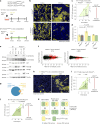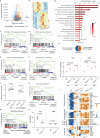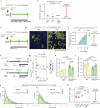Organismal metabolism regulates the expansion of oncogenic PIK3CA mutant clones in normal esophagus
- PMID: 39169259
- PMCID: PMC11525199
- DOI: 10.1038/s41588-024-01891-8
Organismal metabolism regulates the expansion of oncogenic PIK3CA mutant clones in normal esophagus
Abstract
Oncogenic PIK3CA mutations generate large clones in aging human esophagus. Here we investigate the behavior of Pik3ca mutant clones in the normal esophageal epithelium of transgenic mice. Expression of a heterozygous Pik3caH1047R mutation drives clonal expansion by tilting cell fate toward proliferation. CRISPR screening and inhibitor treatment of primary esophageal keratinocytes confirmed the PI3K-mTOR pathway increased mutant cell competitive fitness. The antidiabetic drug metformin reduced mutant cell advantage in vivo and in vitro. Conversely, metabolic conditions such as type 1 diabetes or diet-induced obesity enhanced the competitive fitness of Pik3caH1047R cells. Consistently, we found a higher density of PIK3CA gain-of-function mutations in the esophagus of individuals with high body mass index compared with those with normal weight. We conclude that the metabolic environment selectively influences the evolution of the normal epithelial mutational landscape. Clinically feasible interventions to even out signaling imbalances between wild-type and mutant cells may limit the expansion of oncogenic mutants in normal tissues.
© 2024. The Author(s).
Conflict of interest statement
B.C. is an employee of Altos Labs (Cambridge, UK). B.V. is a consultant for iOnctura (Geneva, Switzerland), Venthera (Palo Alto, CA, United States), Olema Pharmaceuticals (San Francisco, CA, United States) and Pharming (Leiden, The Netherlands). The other authors declare no competing interests.
Figures


















References
-
- Yokoyama, A. et al. Age-related remodelling of oesophageal epithelia by mutated cancer drivers. Nature565, 312–317 (2019). - PubMed
MeSH terms
Substances
Grants and funding
LinkOut - more resources
Full Text Sources
Molecular Biology Databases
Miscellaneous

